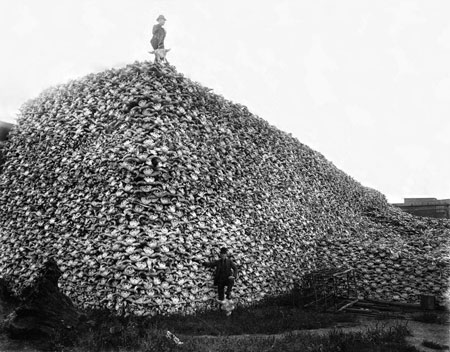Fertilizer History P2
Fertilizer Moves from Bones to Chemistry
A Historical Overview of Fertilizer Use
March 27, 2015
This is the second part of a three-part series. See Part I.
For thousands of years after agriculture came into existence, manure was the main source of fertilizer.

But sometime in the 18th century, it became common knowledge that ground-up bones provided crop nutrients. By 1815, England was importing so many bones from the rest of Europe that people on the continent started complaining that England was robbing all other countries of their fertility.
In the United States, the customary source of bones from livestock packing houses was supplanted by thousands of tons of bison bones covering the western prairies, left from the slaughter of the great buffalo herds. Many early Nebraska homesteaders were saved from bankruptcy by gathering these bones and selling them for processing into fertilizer. Probably little if any of this fertilizer ever made it back to Nebraska.
Although agriculture science was becoming understood in the 18th century, little was known about actual plant nutrition needs. One of the earliest experimental mineral products for agricultural use was gypsum. Scientists at the time were aware that some benefits could be had from the application of
gypsum; however, little was known about its actual mode of action.
It wasn't until the 19th century that ground-breaking research, done by several innovative scientists, finally ushered in the modern era of soil chemistry and plant nutrition. One of the most prominent of these chemists was Justus von Liebig (1803-1873), a German chemist who did pioneering research in
organic and biological chemistry.
Liebig's "Theory of Mineral Nutrients" established the foundation of agricultural chemistry. He determined that the chemical elements of nitrogen (N), phosphorus (P), and potassium (K) are essential to plant growth. To this day N, P and K are considered the fundamental nutrients for crop production.
Liebig's "Law of the Minimum" revealed that maximum plant growth is not determined by total available nutrients, but by the least available nutrients.
The findings of Liebig's research also led him to the conclusion that plant nutrients could be depleted by crop removal and that added fertilizer is needed for optimum crop production. His ground-breaking discoveries facilitated his development of the first nitrogen-based fertilizer and earned him the
title of "Father of the Fertilizer Industry."
Several other scientists followed in Liebig's footsteps. Their discoveries contributed additional knowledge to the basic understanding of plant nutrition and fertilizer development. Of these scientists, the Nobel prize-winning chemists Carl Bosch and Fritz Haber developed the Haber process, which used
molecular nitrogen and methane gas to produce ammonia on an economical and sustainable scale.
Subsequently, the Ostwald process (developed by Wilhelm Ostwald prior to the Haber process) was able to use ammonia from the Haber process to produce nitric acid on a commercial scale. The end result of these discoveries was that most chemical fertilizers could now be produced with nitric acid as
the primary, raw material.
By the beginning of the 20th century, scientists had developed the processes to manufacture ammonia and nitric acid, basic components of many chemical fertilizers.
Gary Hergert, Soil and Nutrient Management Specialist
Rex Nielsen and Jim Margheim, Research Technicians
UNL Panhandle Research and Extension Center
Online Master of Science in Agronomy
With a focus on industry applications and research, the online program is designed with maximum flexibility for today's working professionals.
